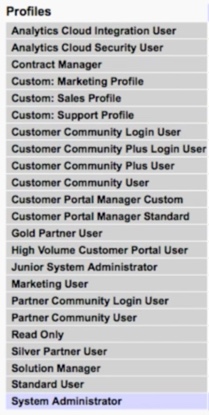Roles, Personas
Overview
There are differant ways Salesforce, project managers, and developers categorize users.
Permissions by Profile
There are many in addition to the 6 standard profiles which can have unique field visibility, page layout, and permissions:
- Administrator
- Solution Manager
- Read Only
- Standard User
- Marketing User
- Contract Manager
Up to 1000 Permission sets per org can be setup to grant additive permissions without changing user profiles.
User Personas
A “persona” represents a group of users clustered based on shared behavior, motivations, goals, pain points, or other characteristics. A persona is an archetype that represents a group of users clustered based on shared behaviors, motivations, goals, pain points, or other characteristics. During the design and development process, persona categories stand in for key user groups when making decisions about your product, by representing major differences between groups. Personas can be useful for building empathy and making the users seem real. Effective personas are created based on research and surveys (pdf) to ensure that they reflect the real people who use your product.*
Personas should be based on work tasks users perform in their roles.
The Trailhead module: Trailhead module: UX Personas for Salesforce [1 hr 10 min] defined by Salesforce were based around the various cloud products: Sales (Marketing) Cloud, Service Cloud, Community Cloud, etc.
- Data Expert
- Deal Closer
- Pipeline Builder
- Sales Leader
- Trusted Advisor
- Service Admin
- Case Solver
- Expert Agent
- Team Leader
- Trusted Advisor
- Designer-Developer
- IT Services
- Marketing Manager
- Marketing Specialist
- Strategic Leader
- Community End User
- Community Manager
- Community Admin
- Community Builder
More about personas:
- https://www.smashingmagazine.com/2014/08/a-closer-look-at-personas-part-1/ recommends use of
-
https://creativecompanion.wordpress.com/2011/05/05/the-persona-core-poster/
-
Full details on creating and using personas is this: http://www.diva-portal.org/smash/get/diva2:319155/FULLTEXT01.pdf
- https://venngage.com/blog/user-persona-examples/ points to
- https://blog.appsee.com/how-to-get-persona-l-with-your-mobile-app-users/
Development Lifecycle Roles
Traditionally, HR departments in classic enterprises have define jobs roles such as these you might see on job boards:
-
Product managers define the business requirements of apps and features, and works with the development team to implement those requirements. The product manager also performs user acceptance testing to ensure that requirements have been implemented.
-
Software developers develop new functionality in sandbox, including both declarative point-and-click development and code.
-
Quality engineers test new functionality.
-
Release managers manage the release schedule and coordinates releases with the business. Some could be in charge of pulling changes from version control and moving them among various environments.
-
Administrators perform administrative tasks in the production org, and tracks all changes made in production.
-
Trainers design and conduct training of employees and partners for new applications and features.
PROTIP: In larger enterprises, such formalizations into separate teams or entire departments of people has attendent communication and coordination issues. Such separation assume an assembly-line approach where one group can pass its output to another group with communication mainly among managers rather than workers.
In smaller, Agile companies, one person may do all the above for a particular product. (“wear many hats”). Or different people in a team assume different roles at different times.
More about Salesforce
This is one of a series about Salesforce
- Salesforce Ohana (about the Salesforce company, offices, mascots, emojis, and store)
- Salesforce Glossary (of acronyms)
- Salesforce Events (Conferences, local Meetups, ) to meet people face-to-face
- Salesforce Exhibitors (at Dreamforce)
- Salesforce Onboarding (Trailhead and IDEs)
- Salesforce Offerings (Clouds, Industries, Domains, GitHub, editions, pricing, features, versions)
- Salesforce Certifications (training and exams)
- Salesforce Projects, Superbadges, and Sample Apps
- Salesforce Project Plans
- Salesforce Jobs (within Salesforce, with partners, etc.)
- Salesforce Apps (in AppExchange)
- Salesforce Alexa
- Salesforce Heroku (external apps)
- Salesforce Non-Profit support
-
Salesforce NPSP (Non-Profit Success Pack) performance (with Gatling)
- Salesforce Data Management
- Salesforce Einstein
- Salesforce Selenium (test automation)


